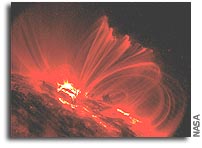Joint USAF/NOAA Report of Solar and Geophysical Activity 17 Feb 2003

SDF Number 048 Issued at 2200Z on 17 Feb 2003
IA. Analysis of Solar Active Regions and Activity from 16/2100Z
to 17/2100Z: Solar activity was at low levels. The largest event
was a C1.9 flare on the west limb. The most likely source was
spotless Region 287 (N12W90). The majority of activity continues to
come from the west limb and consist of B-class and minor C-class
events. The only spotted region on the visible disk in Region 288
(N12E44). This region has remained a stable spot group with a
simple beta magnetic configuration. Surging was the only observed
activity from Region 288.
IB. Solar Activity Forecast: Solar activity is expected to be at
very low to low levels. Region 288 has the potential for C-class
activity.
IIA. Geophysical Activity Summary 16/2100Z to 17/2100Z:
The geomagnetic field was at quiet to unsettled levels. Coronal hole
effects continue to keep solar wind elevated between 600 and 650
km/s and Bz continues to be, on average, slightly negative.
IIB. Geophysical Activity Forecast: The geomagnetic field is
expected to be at quiet to isolated active conditions. Coronal hole
effects are expected to continue through the forecast period.
III. Event Probabilities 18 Feb-20 Feb
- Class M 05/05/05
- Class X 01/01/01
- Proton 01/01/01
- PCAF green
IV. Penticton 10.7 cm Flux
- Observed 17 Feb 112
- Predicted 18 Feb-20 Feb 110/110/110
- 90 Day Mean 17 Feb 147
V. Geomagnetic A Indices
- Observed Afr/Ap 16 Feb 009/015
- Estimated Afr/Ap 17 Feb 012/015
- Predicted Afr/Ap 18 Feb-20 Feb 012/015-015/020-012/015
VI. Geomagnetic Activity Probabilities 18 Feb-20 Feb
A. Middle Latitudes
- Active 25/30/25
- Minor storm 10/15/10
- Major-severe storm 05/10/05
B. High Latitudes
- Active 30/40/30
- Minor storm 25/30/25
- Major-severe storm 15/15/10








